Abstract
Air pollution is closely associated with human health and the economy. Therefore, it is important to understand variations in the spatiotemporal and sectoral emission distributions of major air pollutants and their drivers. The policies (APAPPC) promulgated by China in 2013 have also achieved remarkable results. Rate of change, trend analysis, and a geographically and temporally weighted regression model were used to study the effects of socioeconomic factors on NOx, SO2, and dust emissions in China during 2011–2017. During the study period, annual average emissions of NOx, SO2, and dust decreased by 11.45, 13.42, and 4.82 Mt (−47.64, −60.53, and −39.05%), respectively. Pollutant emissions were concentrated in North China, with Shandong and Hebei provinces exhibiting the highest NOx and SO2 and dust emissions, respectively. Pollutant emissions from the power and industrial sectors were mainly distributed in East (27.08 and 28.00%, respectively) and North China (23.57 and 20.04%, respectively), whereas emissions from the residential sector were mainly concentrated in North (22.48%) and Southwest China (20.07%). Pollutant emissions were positively correlated with electricity generation, urban population density, urban green spaces, private car ownership, the secondary industry as a share of regional GDP, and steel production and negatively correlated with disposable income and gross construction output. Per capita disposable income was the dominant driving factor.
1. Introduction
Air pollution has a significant influence on human health and other socioeconomic aspects. China has become the leading emitter of air pollutants in the world [1,2,3,4,5], and thus, the contributions of various economic sectors to air pollution in China are sought by the government and environmental protection departments. During the 12th Five-Year Plan period (2011–2015), various emission-reduction policies were proposed and implemented. In September 2013, the “Action Plan for Air Pollution Prevention and Control” (APAPPC) was officially promulgated, which identified ten measures (referred to as the “Ten Statements of Atmosphere”) that aim to promote industrial structure optimization, achieve environmental benefits, and improve air quality [6]. Since the implementation of these policies, air pollutant emissions in various regions of China have significantly declined [7,8,9,10].
Quantitative analyses of pollutant emissions form the basis of composite studies on air pollution in China. Previous studies of the primary air pollutants in the atmosphere focused on the construction of an emission inventory of pollutants [8,11], analysis of emission sources [12,13] and spatial and temporal distributions of pollutants [14,15], trend prediction [16,17] and determination of driving factors [18,19,20]. Zhou et al. [21] analyzed the variations in the emission concentrations of six major air pollutants and the air quality index (AQI) in Chinese cities from 2015 to 2018, they found that the AQI concentrations were positively and significantly associated with concentrations of PM2.5, PM10, SO2, NO2, CO, and the concentrations of SO2, NO2, and PM2.5 decreased significantly during the study period; moreover, they observed a strong correlation between industrial production capacity and air pollution levels and suggested that traffic emissions caused by micro cars and heavy trucks should be controlled. Wang et al. [22] analyzed the spatial and temporal changes in industrial pollutant emissions and their determinants in the Yangtze River Economic Zone. Gross domestic product (GDP) per capita, secondary industry, population density, and energy use showed positive correlations with pollutant emissions, and a “pollution refuge” phenomenon was observed in the central and western regions of China. Xu et al. [23] examined changes in air pollutant concentrations in Chinese megacities from 2018 to 2020, as well as their drivers, and quantified the contributions of individual meteorological factors and their precursors to PM2.5 and O3 using the generalized additive model. Daily changes in PM2.5 concentrations were strongly related to changes in precursor gases, whereas meteorological conditions mainly affected the daily changes in O3 concentrations. Zhao et al. [24] found that after the implementation of air pollution control policies in China, the concentrations of major pollutants have declined significantly; however, most people are still exposed to high risk levels of PM2.5 and O3.
Most previous air pollution studies have focused on a single sector and single air pollutant. Comparative analyses of the factors influencing multiple air pollutants are currently lacking. Therefore, in this study, we examined air pollutant emission data from 2011 to 2017 for each province (city and district) in China, alongside nationwide data for the power, industrial, residential, and transportation sectors. Based on the main types of environmental emissions covered in the 13th Five-Year Plan for Environmental Protection, three major air pollutants (NOx, SO2, and dust) were investigated. Emission change rates, trend analysis, and a geographically and temporally weighted regression (GTWR) model were used to analyze variation in the temporal and spatial emission distributions of major air pollutants at national, regional, and provincial scales and sector wise. The results of this study can aid in understanding future trends in air pollution emissions in China and the influence of various drivers, which can be used to formulate air quality control policies to reduce future emissions.
2. Data Sources and Research Methods
2.1. Study Area
Mainland China was taken as the study area, which includes 31 provinces (autonomous regions and municipalities directly under the central government). It is divided into seven geographical regions: Northeast China (Liaoning, Jilin, and Heilongjiang), North China (Beijing, Tianjin, Hebei, Shanxi, and Inner Mongolia), East China (Shanghai, Jiangsu, Zhejiang, Anhui, Fujian, Jiangxi, and Shandong), Central China (Henan, Hubei, and Hunan), South China (Guangdong, Guangxi, and Hainan), Northwest China (Shaanxi, Gansu, Qinghai, Ningxia, and Xinjiang), and Southwest China (Chongqing, Sichuan, Guizhou, Yunnan, and Tibet). Owing to limited data availability, Taiwan, Hong Kong, and Macao were not included in the study (Figure 1).
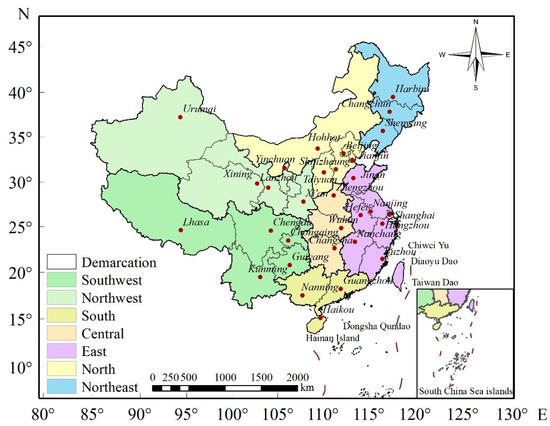
Figure 1.
Map of China. (The seven geographical divisions in China are divided by the black color solid line).
2.2. Data Sources
NOx, SO2, and dust annual emissions data for the period 2011–2017 for each province (district and city) in China were obtained from the EPSDATA database (https://www.epsnet.com.cn/index (accessed on 5 September 2022)). Annual emission data for the power, industrial, residential, and transportation sectors for the period 2011–2017 for each province (district and city) in China were obtained from the Multi-resolution Emission Inventory for China (http://meicmodel.org/ (accessed on 5 September 2022)). Socioeconomic indicators for each province (district and city) every year were obtained from the China Urban Statistical Yearbook and provincial and municipal statistical yearbooks (http://www.stats.gov.cn (accessed on 20 September 2022)).
2.3. Rate of Change of Pollutant Emissions
The rate of change of pollutant emissions (ROC) is the average change in pollutant emissions per time interval and represents the change in emissions of a particular air pollutant within a fixed time frame [25,26].
where B and A are the air pollutant emissions at the beginning and end of the study period, respectively.
2.4. Trend Analysis
Trend analyses can be used to estimate the linear slope of a given time series and explore interannual variability [27]. In this study, we analyzed the trends of various pollutant emissions using the following equation:
where n is the time span, i is the year (i = 7 in this study), and Q is the pollutant emissions in the ith year. With time as the horizontal axis, a one-dimensional linear regression was performed on the time series data of various pollutant emissions. Theoretically, if the variables change smoothly, the slope is likely to be similar to the rate of change, which reflects the trend [28]. When the slope is positive, it indicates an increasing trend in the data, when the slope is negative, it indicates a decreasing trend in the data; if the slope is close to zero, there is almost no change in the data.
2.5. GTWR Model
The geographically weighted regression (GWR) model is a statistical method for modeling spatially heterogeneous processes, which allows the relationship between the response variable and a set of covariates to vary over geographic space. However, the GWR model only considers the effect of space on the regression coefficients, which may produce large biases in the results when the effect of time on some variables is large [29,30]. This limitation can be overcome using the GTWR model that adds a temporal dimension and provides an analytical basis for simultaneously dealing with spatiotemporal non-stationarity. The mathematical expression of the GTWR model is as follows:
where (, , ) are the spatiotemporal coordinates of the ith sample (time units are years, months, or days)., , is the regression coefficient of the kth independent variable of the ith spatiotemporal sample determined by the geographical location and time of the ith sample. denotes the random error of the ith spatiotemporal sample and satisfies a normal distribution with a mathematical expectation of zero and variance of . The random errors of sampling points i and j are independent of each other, and their covariances are zero. , , ) estimates are expressed as follows:
where is the estimate, W is the spatiotemporal weight matrix, and X is the matrix composed of independent variables.
XT is the transpose of the matrix, and Y is a matrix composed of observations. The selection of the spatiotemporal weight matrix and bandwidth is the core of the GTWR. In this study, temporal and spatial weight matrices were determined using the Gaussian function method:
where is a spatiotemporal weight matrix; is the spatiotemporal distance between observation points i and j, where i and j are different sample regions; and is the bandwidth. The bandwidth of the kernel function has a significant effect on the geographically weighted regression. A bandwidth that is too large considers points that have less influence on the estimated points during the fitting period, whereas a bandwidth that is too small may lead to overfitting. Akaike information criterion was used for bandwidth selection.
3. Results and Discussion
3.1. Spatial and Temporal Patterns of Air Pollutant Emissions in China
3.1.1. Temporal Changes in Air Pollutant Emissions
From 2011 to 2017, the national NOx, SO2, and dust emissions all showed a fluctuating decreasing trend (Figure 2), and total emissions of the three pollutants decreased by 29.71 Mt (50.34%). The annual emissions of NOx, SO2, and dust decreased by 11.45 Mt (47.64%), 13.43 Mt (60.53%), and 4.83 Mt (39.05%), respectively; SO2 emissions decreased the most, and those of dust decreased the least. The ROC of pollutant emissions changed remarkably from 2014. Dust emissions increased sharply by 4.62 Mt in the period 2013–2014, but the average annual ROC thereafter was −13.56%. The average annual ROC of NOx and SO2 emissions were −9.86 and −13.92%, respectively. The decline in each pollutant emission was much steeper from 2014 onward. Compared with the annual average decline in the emissions of various pollutants prior to 2014, which changed by −7.40, −11.30, and −13.55 Mt/a, respectively, pollutant emissions decreased as the ROC increased.
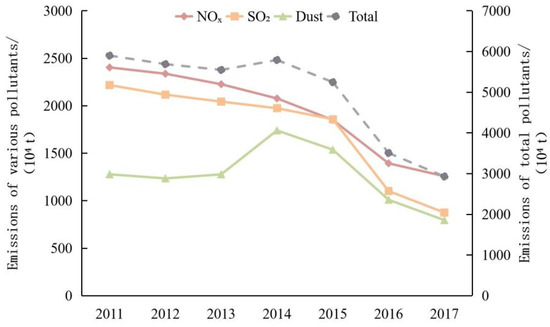
Figure 2.
Changes in annual average emissions of three air pollutants (NOx, SO2, and dust) in China (2011–2017).
3.1.2. Spatial Distribution of Air Pollutant Emissions in China
The spatial distribution of air pollutant emissions in China from 2011 to 2017 is shown in Figure 3. At the provincial level, the highest NOx emissions were from Shandong, Hebei, and Henan, with emissions (national share) of 1.511 Mt (7.81%), 1.47 Mt (7.57%), and 1.29 Mt (6.65%), respectively. The highest SO2 emissions were from Shandong, Inner Mongolia, and Shanxi, with emissions (national share) of 1.46 Mt (8.38%), 1.12 Mt (6.45%), and 1.08 Mt (6.19%), respectively. Dust emissions were highest in Hebei, Shanxi, and Shandong, with emissions (national share) of 1.33 Mt (10.48%), 1.04 Mt (8.22%), and 0.84 Mt (6.63%), respectively. Tibet, Hainan, Beijing, and Qinghai had the lowest pollutant emissions. At the regional level, the regions with the highest emissions of NOx, SO2, and dust were all in North China, with emissions (national share) of 2.16 Mt (19.45%), 0.79 Mt (18.20%), and 0.71 Mt (18.29%), respectively. The regions with the lowest emissions were all in South China, except for SO2, which showed the lowest emissions in Southwest China. Average emissions of NOx, SO2, and dust in South China were 1.12 Mt (9.97%), 0.38 Mt (8.61%), and 0.36 Mt (9.10%), respectively.
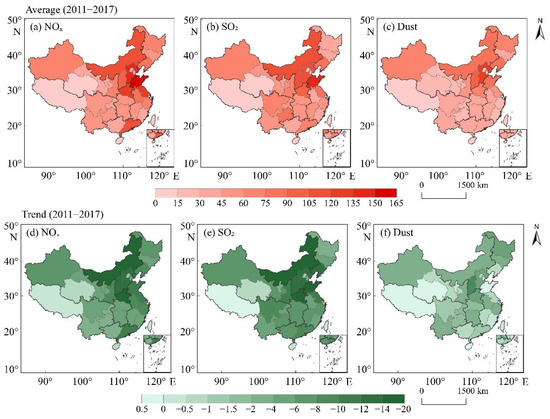
Figure 3.
Spatial distribution of the (a,b,c) emissions of three air pollutants (NOx, SO2, and dust) in China (2011–2017) and (d,e,f) trend values for provincial units.
The spatial distributions and trends of NOx, SO2, and dust emissions were further analyzed. The emissions of the three pollutants showed an average change of −2.04 Mt/a, −2.23 Mt/a, and −0.59 Mt/a, respectively, between 2011 and 2017. NOx emissions in all regions of the country showed a decreasing trend from 2011 to 2017, with the largest decrease observed in Henan (−0.177 Mt/a), Inner Mongolia (−0.162 Mt/a), and Hebei (−0.136 Mt/a). SO2 emissions decreased in all regions of the country except Tibet (0.005 Mt/a), with the largest decreases in Henan (−0.182 Mt/a), Shandong (−0.165 Mt/a), and Inner Mongolia (−0.151 Mt/a). Dust emissions showed increases in Qinghai (0.0011 Mt/a), Hainan (0.0009 Mt/a), and Tibet (0.0007 Mt/a), and the provinces which exhibited the largest decreases were Shanxi (−0.0873 Mt/a), Henan (−0.0526 Mt/a), and Heilongjiang (−0.048 Mt/a).
3.2. Air Pollutant Emissions by Sector in China
3.2.1. Temporal Changes in Air Pollutant Emissions
The composition of the main pollutants emitted by sectors is different, and there are various emission reduction measures for sectors in APAPPC. Pollutant emissions in the power, industrial, residential, and transportation sectors showed a decreasing trend from 2011 to 2017 (Figure 4), with relative changes of −62.93, −45.18, −30.17, and −1.42%, respectively. The most significant reduction was observed in the power sector and the least significant reduction in the transportation sector. Specifically, NOx emissions showed the largest reduction in the power sector (−55.89%; Table 1). SO2 emissions from the power and industrial sectors showed notable reductions (−76.89 and −65.55%, respectively); however, emissions from the transportation sector increased by 32.12%. Dust emissions showed the greatest reduction in the industrial sector (−46.42%) but increased in the transportation sector (4.06%).
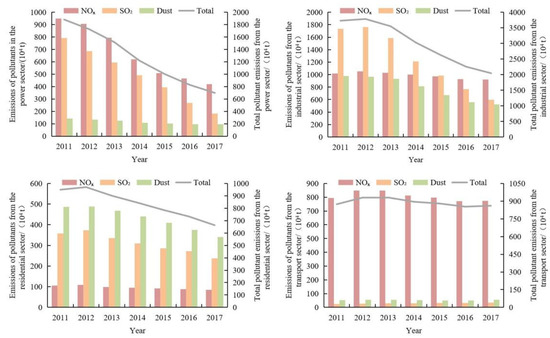
Figure 4.
Emissions of NOx, SO2, and dust in China (2011–2017) from various economic sectors.

Table 1.
Proportional emissions reductions in different economic sectors in China (2011–2017).
3.2.2. Spatial Variation in Emissions by Sector
The temporal variations in pollutant emissions by sector for each province and region are shown in Figure 5. Cluster analysis showed that pollutant emissions could be divided into two periods: 2011–2013 and 2014–2017.
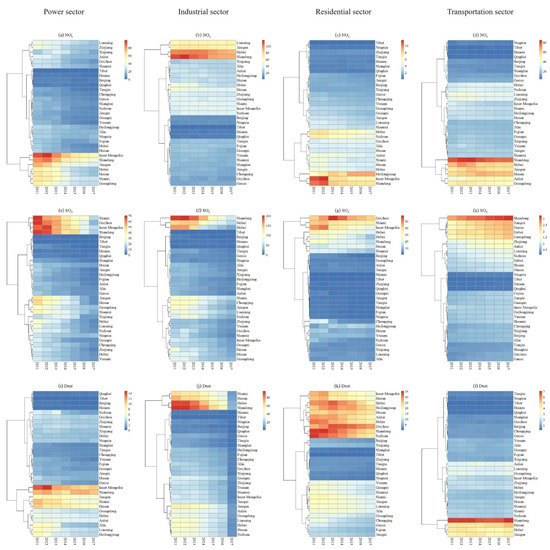
Figure 5.
Distribution of pollutant (NOx, SO2, and dust) emissions from the (a,e,i) power sector, (b,f,j) industrial sector, (c,g,k) residential sector and (d,h,l) transportation sector in China (2011−2017).
Pollutant emissions from the power sector (Figure 5a,e,i) were mainly distributed in East and North China, with contributions of 27.08 and 23.57%, respectively. The main emission types for this sector, NOx and SO2, were spatially clustered. Provinces with higher NOx emissions were Inner Mongolia, Shandong, and Jiangsu, with cumulative emissions of 0.734, 0.643, and 0.492 Mt, respectively. Provinces with higher SO2 emissions were Shandong, Inner Mongolia, Shanxi, and Guizhou, with cumulative emissions of 0.459, 0.450, 0.434 and 0.431 Mt. Industrial sector emissions were mainly concentrated in East and North China, with contributions of 28.00 and 20.04%, respectively. The spatial clustering of emissions from the industrial sector was divided into four groups. Provinces with high NOx emissions were Shandong, Hebei, Jiangsu, and Liaoning, with cumulative emissions of 1.02, 0.96, 0.69, and 0.65 Mt, respectively. Provinces with high SO2 emissions were Shandong, Hubei, and Hebei, with cumulative emissions of 1.40, 0.89, and 1.02 Mt. The provinces with the highest dust emissions were Shandong, Hebei, Henan, and Shanxi, with cumulative emissions of 0.70, 0.64, 0.50, and 0.46 Mt, respectively.
Emissions from the residential sector were mainly concentrated in North and Southwest China, with contributions of 22.48 and 20.07%, respectively. Emissions of the main pollutant for this sector, dust, showed spatial clustering but were generally more balanced than those for other sectors. Ten regions showed high emissions, with a total contribution of 58.22%, of which the total emissions of Shandong and Sichuan exceeded 10%. Emissions from the transportation sector were mainly distributed in East China (32.74%). The three pollutants had particularly high emissions in Shandong Province, with cumulative emissions of NOx, SO2, and dust being 0.80, 0.03, and 0.068 Mt, respectively. The regions with the lowest emissions for each sector were Tibet, Hainan, Qinghai, Beijing, and Ningxia, with a cumulative emission contribution of less than 1%.
3.3. Drivers of Atmospheric Pollutant Emissions
Model Construction
Pollutant emissions (ln(NOx), ln(SO2), and ln(dust)) were used as the explanatory variables, and the number of enterprise units, electricity generation (GC), disposable income (DI), gross regional product, urban population density (UD), urban green space area (UGSA), built-up area, gross output value of the construction industry (GCI), area of housing construction in the construction industry, total population at the end of the year, cement production, electricity consumption, private car ownership (PVO), value added of the secondary industry as a proportion of regional GDP (SIS), steel production (SP), and other relevant data were used as explanatory variables. All parameters were chosen as independent variables, and preliminary analyses showed a clear collinearity issue. Therefore, a variance inflation factor (VIF) was introduced, and a STATA regression analysis was used to test the covariance of the independent variables and measure the closeness of the correlations. The variables shown in Table 2 were screened to fit the model based on the criterion that the VIF should be less than 7.5 (Table 2).

Table 2.
Collinearity test results.
By exploring the fit of different models, we derived the parameters listed in Table 3. The results showed that the GTWR model performed significantly better than the ordinary least square (OLS) model in terms of goodness of fit. The adjusted R2 values for the three explanatory variables of the GTWR model were 0.993, 0.972, and 0.982, respectively, indicating that the model explained the effects of each variable on pollutant emissions well, and the fit was good. In addition, the Akaike Information Guide (AICc) for the GTWR model is smaller than the corresponding value in the OLS model. The results show that the explanatory variables of the GTWR model have a strong explanatory degree on (ln(NOx), ln(SO2), and ln(dust)), which can better explain the data with spatiotemporal heterogeneity.

Table 3.
Related parameters of the geographically and temporally weighted regression (GTWR) model.
3.4. Spatial Evolution of Drivers
Air pollutant emissions are influenced by the interactions of various factors, and the dominant drivers may change over time, characterized by dynamic changes in their spatial patterns [31]. Analyzing the spatial and temporal changes in each influencing factor from 2011 to 2017 helped to discern the dominant influencing factors in different regions. This information can be used to formulate reasonable emissions reduction proposals and joint prevention and control in each region.
Based on the coefficients of each variable for the three pollutants (Table 4), the variables had different effects on each. The signs of the respective coefficients also varied over time, highlighting the spatial and temporal heterogeneity exhibited by the variables. Among them, electricity generation had a significant positive effect on pollutant emissions, whereas disposable income had an inhibitory effect.

Table 4.
Ranking of socioeconomic factors on the impact of three pollutant emissions.
The coefficient for electricity generation was higher in the western regions and lower in the eastern and Central regions (Figure 6a, Figure 7a and Figure 8a). The differences across regions may be related to factors such as the level of regional pollution control technology, fuel mix, and power mix [32]. Owing to the lack of wind, hydro, and solar energy, the eastern regions rely more on thermal power generation, whereas the Central region has the largest contribution from hydroelectric power generation. In addition, the state set ultra-low NOx emissions standards for thermal power plants, and energy efficiency technology standards are updated frequently under strict regulations in eastern China. These policies would be expected to mobilize financial investment in efforts to mitigate negative effects on the environment [33]. The ROC of the NOx coefficients decreased, and the rate of increase in the SO2 coefficients increased after 2014. There are two main aspects of power generation that produce air pollutant emissions: pollutant gases from the combustion of coal consumed in power generation and gases such as SO2, NOx, and CO. These gases react physicochemically with other substances in the air, causing secondary pollution. Pollutants accumulate in the air and form particulate matter, such as PM2.5. Thermal power plants produce dust, soot, and other pollutants during power generation.
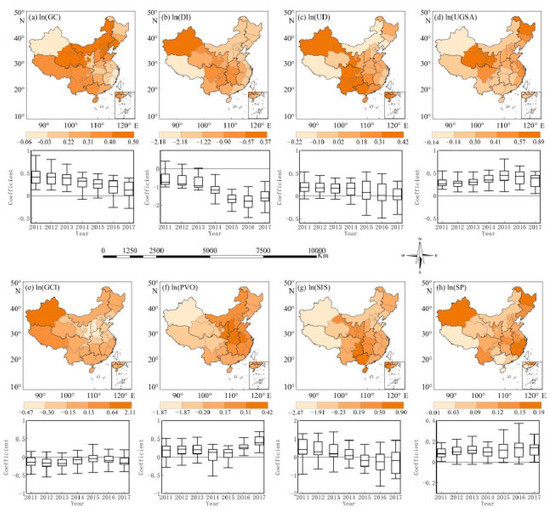
Figure 6.
Spatial distribution and temporal variation in various coefficients of NOx in the geographically and temporally weighted regression (GTWR) model.
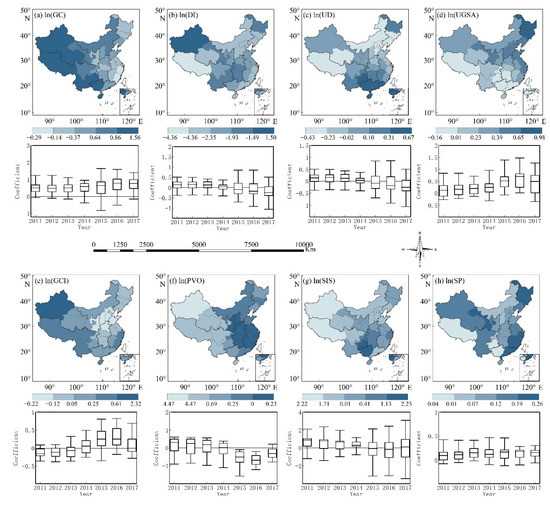
Figure 7.
Spatial distribution and temporal variations in various coefficients of SO2 in the geographically and temporally weighted regression (GTWR) model.
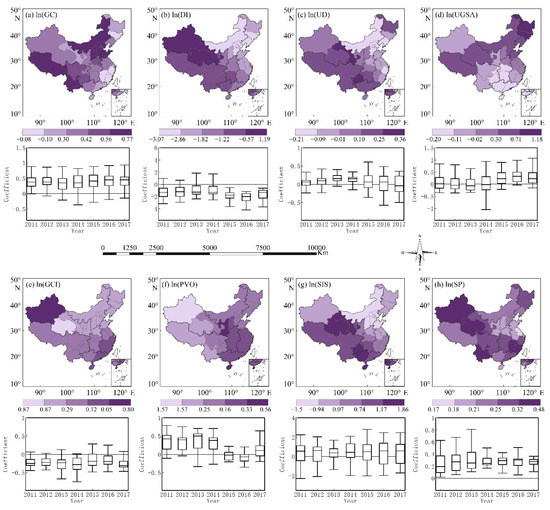
Figure 8.
Spatial distribution and temporal variations in various coefficients of dust in the geographically and temporally weighted regression (GTWR) model.
Economic development brought about an increase in per capita disposable income, and the inhibitory effect of income on NOx and dust pollutant emissions gradually increased from 2011 to 2017. The effect on SO2 changed from promotion to inhibition and continued to increase. This finding is consistent with the hypothesis of the environmental Kuznets curve (EKC), which states that environmental pollution increases with an increase in per capita income up to a certain level, i.e., the “inflection point”, at which point environmental pollution will slow with additional increases in income [34]. The inhibitory effect was significantly higher in eastern China than in western China (Figure 6, Figure 7 and Figure 8b) because economic development in the western region lags behind that in the East. The southeast coastal region of China is economically developed and has already crossed the inflection point of the EKC curve, and the disincentive effect gradually increases with increasing income [35]. The eastern coastal region should pay attention to green and low-carbon development models and environmental protection during economic development.
Urban green space areas, the value added of the secondary industry as a proportion of regional GDP, and steel production also had some influence on pollutant emissions. Urban green spaces had a positive effect on pollutant emissions in most regions and showed a fluctuating upward trend. Specifically, pollutant emissions in the Central, Western, and Northeast China showed a promotional effect, whereas all other regions had a suppressing effect. The degree of greenspace landscape fragmentation, landscape dominance, patch shape complexity, and patch dispersion can influence pollutant abatement ability [36]. In areas where it is difficult to reduce pollutants by increasing the green space area because of land constraints, pollutant emissions can be influenced by changing the landscape patterns of green areas. The proportional value added by the secondary industry to regional GDP was also a key factor affecting pollutant emissions. Secondary industries include mining, manufacturing, electricity, heat, gas, water production and supply, and construction. The distribution of this coefficient showed a general spatial pattern of higher values in South China and lower in North China, with higher coefficients in the Northeast, South, Southwest, and part of Central China (Figure 6g, Figure 7g and Figure 8g). After 2013, the impact of secondary industry on NOx and dust emissions gradually increased, whereas that on SO2 gradually decreased. The coefficient changed most in the southeast, especially in the southeast coastal cities [37]. This may be because the southeast region has completed the upgradation of its economic structure [38].
The steel industry is a key concern of China’s pollution prevention and control and emission restriction strategies. An increase in steel demand has driven steel production and pollutant emissions, of which the pollutant emissions studied were mainly from coking, sintering, pellets, and blast furnaces [39]. The influence of steel production on pollutant emissions can be observed in some regions, including Heilongjiang, Liaoning, Jiangsu, Jiangxi, Zhejiang, Tibet, and Yunnan. These regions produce large amounts of pollutants. There is an urgent need for ultra-low emission reform in the steel industry in key provinces and the implementation of real-time monitoring to effectively reduce steel pollutant emissions.
Urban population density (Figure 6c, Figure 7c and Figure 8c), private vehicle ownership (Figure 6f, Figure 7f and Figure 8f), and gross construction output (Figure 6e, Figure 7e and Figure 8e) had different effects on the emissions of the three pollutants. The distribution of urban population density coefficients was roughly demarcated by the Hu Huanyong line, with larger coefficients in Southwest China and smaller coefficients and negative values in Northeast China. The pollutant emission impact coefficient as a whole also showed a gradually decreasing trend, changing from promotion to suppression. This result may be because population agglomeration can lead to the spatial aggregation of economic activities and production. This shift can increase the sharing of infrastructure, thus improving the comprehensive utilization efficiency of energy and resources, maximizing the cost savings of emission reduction, promoting the centralized supervision of government departments, and providing the possibility of centralized control of pollutant emissions [40]. Population size was a dominant factor in all regions in China, with high population density and rapid economic development in the Central and eastern regions. Private car ownership increased over time, and the coefficient distribution showed a spatial pattern of high values in the East and low in the West.
High traffic load pressure directly leads to increased energy consumption and higher pollutant emissions. Gross construction output value and private car ownership had different effects on the three pollutants. The gross construction output showed a gradual shift to a promoting effect on SO2 emissions but had a significant inhibitory effect on NOx and dust. The construction industry is typically energy intensive, consuming a large amount of non-renewable energy and mineral resources; at the same time, a large amount of greenhouse gas emissions cause air pollution [41]. According to the results in Figure 6e, Figure 7e and Figure 8e, the construction industry showed a suppressive effect on pollutant emissions in some provinces in the Central region and a catalytic effect in other regions. Dust generated by construction activities had a considerable influence on the atmospheric environment. From the perspective of environmental protection, it is important to avoid unnecessary construction activities, optimize the structure of China’s economy and energy use, improve resource-use efficiency, and reduce the export of products with high energy or resource consumption [42].
4. Conclusions
From 2011 to 2017, China’s air pollutant emissions generally showed a decreasing trend. NOx and SO2 decreased year by year, and dust showed an increasing and then decreasing trend. Annual average emissions of NOx, SO2, and dust decreased by 11.45 Mt (−47.64%), 13.42 Mt (−60.53%), and 4.82 Mt (−39.05%), respectively.
The geospatial analyses revealed that pollutant emissions were the highest in North China from 2011 to 2017. The lowest emissions, except those of SO2, were in Southwest and South China. Hebei, Shandong, and Shanxi provinces had the highest emissions. NOx and SO2 emissions were concentrated in North and Central China, and the province with the highest emissions was Shandong Province at 1.51 Mt (7.81%) and 1.46 Mt (8.38%), respectively. Dust emissions were concentrated in North China, and Hebei showed the highest emissions among the provinces at 0.13 Mt (10.48%).
The emissions of the three pollutants in different sectors showed decreasing trends each year. The ROC values were −15.16, −11.94, −5.74, and −0.18, respectively. Pollutant emissions from the energy sector were mainly distributed in East China (27.08%) and North China (23.57%); pollutant emissions from the industrial sector were mainly concentrated in East (28.00%) and North China (20.04%), whereas the residential sector emissions were mainly concentrated in North (22.48%) and Southwest China (20.07%); the transportation sector emissions were mainly distributed in East China (32.74%).
Each influencing factor exhibited spatial and temporal heterogeneity. Pollutant emissions were positively correlated with electricity generation, urban population density, urban green space, private car ownership, value added of the secondary industry as a share of regional GDP, and steel production and negatively correlated with disposable income and gross construction output (population density and private car ownership have gradually changed to inhibit SO2 pollutant emissions, and gross construction output has gradually changed to promote them). The average regression coefficients of disposable income per capita for NOx, SO2, and dust were −1.13, −2.13, and −1.51, respectively, which was the dominant factor affecting pollutant emissions.
Author Contributions
Conceptualization, Y.T. and C.H.; methodology, Y.T., C.H. and L.Y.; validation, J.Y.; formal analysis, Y.T.; resources, C.H.; writing—original draft preparation, Y.T.; writing—review and editing, P.T. and Z.Y.; visualization, Y.T., B.K. and H.M.; supervision, S.H. All authors have read and agreed to the published version of the manuscript.
Funding
This research received no external funding.
Institutional Review Board Statement
Not applicable.
Informed Consent Statement
Not applicable.
Data Availability Statement
The datasets analyzed during the current study are available in the Multi-resolution Emission Inventory for China (http://meicmodel.org/ (accessed on 5 September 2022)). The datasets generated and/or analyzed during the current study are available in the EPSDATA database (https://www.epsnet.com.cn/index (accessed on 5 September 2022)). The datasets generated and/or analyzed during the current study are available in the National Bureau of Statistics of the People’s Republic of China repository, (http://data.stats.gov.cn (accessed on 20 September 2022)).
Acknowledgments
The authors would like to thank all those who contributed to this research.
Conflicts of Interest
The authors declare no conflict of interest.
References
- Chen, F.; Chen, Z. Science of the Total Environment Cost of Economic Growth: Air Pollution and Health Expenditure. Sci. Total Environ. 2021, 755, 142543. [Google Scholar] [CrossRef] [PubMed]
- Hadley, M.B.; Vedanthan, R.; Fuster, V. Air Pollution and Cardiovascular Disease: A Window of Opportunity. Nat. Rev. Cardiol. 2019, 15, 193–194. [Google Scholar] [CrossRef] [PubMed]
- Yin, P.; Brauer, M.; Cohen, A.J.; Wang, H.; Li, J.; Burnett, R.T.; Stanaway, J.D.; Causey, K.; Larson, S.; Godwin, W.; et al. Articles the Effect of Air Pollution on Deaths, Disease Burden, and Life Expectancy across China and Its Provinces, 1990–2017: An Analysis for the Global Burden of Disease Study 2017. Lancet Planet. Health 2020, 4, e386–e398. [Google Scholar] [CrossRef] [PubMed]
- Hao, Y.; Zheng, S.; Zhao, M.; Wu, H.; Guo, Y. Reexamining the Relationships among Urbanization, Industrial Structure, and Environmental Pollution in China—New Evidence Using the Dynamic Threshold Panel Model. Energy Rep. 2020, 6, 28–39. [Google Scholar] [CrossRef]
- Mohaddeseh, A.; Feng, F.; Chongyang, Z. Environmental Policy Innovation in China and Examining Its Dynamic Relations with Air Pollution and Economic Growth Using SEM Panel Data. Environ. Sci. Pollut. Res. 2020, 27, 9987–9998. [Google Scholar]
- State Council. Notice of the State Council on the Issuance of the Action Plan for the Prevention and Control of Air Pollution. Available online: http://www.gov.cn/zhengce/content/2013-09/13/content_4561.htm (accessed on 10 August 2022).
- Geng, G.; Xiao, Q.; Zheng, Y.; Tong, D.; Zhang, Y.; Zhang, X.; Zhang, Q.; He, K.; Liu, Y. Impact of China’s Air Pollution Prevention and Control Action Plan on PM2.5 chemical composition over eastern China. Sci. China Earth Sci. 2019, 62, 1872–1884. [Google Scholar] [CrossRef]
- Zheng, B.; Tong, D.; Li, M.; Liu, F.; Hong, C.; Geng, G.; Li, H.; Li, X.; Peng, L.; Qi, J.; et al. Trends in China’s Anthropogenic Emissions since 2010 as the Consequence of Clean Air Actions. Atmos. Chem. Phys. 2018, 18, 14095–14111. [Google Scholar] [CrossRef]
- Wu, W.; Xue, W.; Wang, Y.; Lei, Y.; Feng, T.; Cai, Z. Health Benefit Evaluation for Air Pollution Prevention and Control Action Plan in China. Environ. Sci. 2019, 40, 2961–2966. [Google Scholar] [CrossRef]
- Feng, Y.; Ning, M.; Lei, Y.; Sun, Y.; Liu, W.; Wang, J. Defending Blue Sky in China: Effectiveness of the “Air Pollution Prevention and Control Action Plan” on Air Quality Improvements from 2013 to 2017. J. Environ. Manag. 2019, 252, 109603. [Google Scholar] [CrossRef]
- Kuenen, J.; Dellaert, S.; Visschedijk, A.; Jalkanen, J.-P.; Super, I.; Denier van der Gon, H. CAMS-REG-v4: A State-of-the-Art High-Resolution European Emission Inventory for Air Quality Modelling. Earth Syst. Sci. Data 2022, 14, 491–515. [Google Scholar] [CrossRef]
- Zhao, Y.; Xi, M.; Zhang, Q.; Dong, Z.; Ma, M.; Zhou, K.; Xu, W.; Xing, J.; Zheng, B.; Wen, Z.; et al. Decline in Bulk Deposition of Air Pollutants in China Lags behind Reductions in Emissions. Nat. Geosci. 2022, 15, 190–195. [Google Scholar] [CrossRef]
- Wang, S.; Liu, J.; Yi, H.; Tang, X.; Yu, Q.; Zhao, S.; Gao, F.; Zhou, Y.; Zhong, T.; Wang, Y. Trends in Air Pollutant Emissions from the Sintering Process of the Iron and Steel Industry in the Fenwei Plain and Surrounding Regions in China, 2014–2017. Chemosphere 2022, 291, 132917. [Google Scholar] [CrossRef]
- He, C.; Hong, S.; Zhang, L.; Mu, H.; Xin, A.; Zhou, Y.; Liu, J.; Liu, N.; Su, Y.; Tian, Y.; et al. Global, Continental, and National Variation in PM2.5, O3, and NO2 Concentrations during the Early 2020 COVID-19 Lockdown. Atmos. Pollut. Res. 2021, 12, 136–145. [Google Scholar] [CrossRef]
- Fan, H.; Zhao, C.; Yang, Y. A Comprehensive Analysis of the Spatio-Temporal Variation of Urban Air Pollution in China during 2014–2018. Atmos. Environ. 2020, 220, 117066. [Google Scholar] [CrossRef]
- Liu, Y.; Tong, D.; Cheng, J.; Davis, S.J.; Yu, S.; Yarlagadda, B.; Clarke, L.E.; Brauer, M.; Cohen, A.J.; Kan, H.; et al. Role of Climate Goals and Clean-Air Policies on Reducing Future Air Pollution Deaths in China: A Modelling Study. Lancet Planet. Health 2022, 6, e92–e99. [Google Scholar] [CrossRef]
- Bakır, H.; Ağbulut, Ü.; Gürel, A.E.; Yıldız, G.; Güvenç, U.; Soudagar, M.E.M.; Hoang, A.T.; Deepanraj, B.; Saini, G.; Afzal, A. Forecasting of Future Greenhouse Gas Emission Trajectory for India Using Energy and Economic Indexes with Various Metaheuristic Algorithms. J. Clean. Prod. 2022, 360, 131946. [Google Scholar] [CrossRef]
- Yan, Y.; Wang, X.; Huang, Z.; Qu, K.; Shi, W.; Peng, Z.; Zeng, L.; Xie, S.; Zhang, Y. Impacts of Synoptic Circulation on Surface Ozone Pollution in a Coastal Eco-City in Southeastern China during 2014-2019. J. Environ. Sci. 2023, 127, 143–157. [Google Scholar] [CrossRef]
- Liu, L.-J.; Liang, Q.-M.; Creutzig, F.; Cheng, N.; Liu, L.-C. Electricity End-Use and Construction Activity Are Key Leverage Points for Co-Controlling Greenhouse Gases and Local Pollution in China. Clim. Change 2021, 167, 19. [Google Scholar] [CrossRef]
- He, C.; Hong, S.; Mu, H.; Tu, P.; Yang, L.; Ke, B.; Huang, J. Characteristics and Meteorological Factors of Severe Haze Pollution in China. Adv. Meteorol. 2021, 2021, e6680564. [Google Scholar] [CrossRef]
- Zhou, X.; Strezov, V.; Jiang, Y.; Kan, T.; Evans, T. Temporal and Spatial Variations of Air Pollution across China from 2015 to 2018. J. Environ. Sci. 2022, 112, 161–169. [Google Scholar] [CrossRef]
- Wang, Y.; Duan, X.; Wang, L.; Zou, H. Spatial Temporal Patterns and Driving Factors of Industrial Pollution and Structures in the Yangtze River Economic Belt. Chemosphere 2022, 303, 134996. [Google Scholar] [CrossRef] [PubMed]
- Xu, T.; Zhang, C.; Liu, C.; Hu, Q. Variability of PM2.5 and O3 Concentrations and Their Driving Forces over Chinese Megacities during 2018–2020. J. Environ. Sci. 2023, 124, 1–10. [Google Scholar] [CrossRef] [PubMed]
- Zhao, H.; Chen, K.; Liu, Z.; Zhang, Y.; Shao, T.; Zhang, H. Coordinated Control of PM 2.5 and O3 Is Urgently Needed in China after Implementation of the “Air Pollution Prevention and Control Action Plan. Chemosphere 2021, 270, 129441. [Google Scholar] [CrossRef] [PubMed]
- Shi, Y.; Xiao, J.; Shen, Y.; Yamaguchi, Y. Quantifying the Spatial Differences of Landscape Change in the Hai River Basin, China, in the 1990s. Int. J. Remote Sens. 2012, 33, 4482–4501. [Google Scholar] [CrossRef]
- He, C.; Yang, L.; Cai, B.; Ruan, Q.; Hong, S.; Wang, Z. Impacts of the COVID-19 Event on the NOx Emissions of Key Polluting Enterprises in China. Appl. Energy 2021, 281, 116042. [Google Scholar] [CrossRef]
- Shi, Y.; Matsunaga, T.; Yamaguchi, Y.; Zhao, A.; Li, Z.; Gu, X. Science of the Total Environment Long-Term Trends and Spatial Patterns of PM 2. 5 -Induced Premature Mortality in South and Southeast Asia from 1999 to 2014. Sci. Total Environ. 2018, 631–632, 1504–1514. [Google Scholar] [CrossRef]
- Bai, K.; Ma, M.; Chang, N.B.; Gao, W. Spatiotemporal Trend Analysis for Fine Particulate Matter Concentrations in China Using High-Resolution Satellite-Derived and Ground-Measured PM2.5 Data. J. Environ. Manag. 2019, 233, 530–542. [Google Scholar] [CrossRef]
- Fotheringham, A.S.; Crespo, R.; Yao, J. Geographical and Temporal Weighted Regression (GTWR). Geogr. Anal. 2015, 47, 431–452. [Google Scholar] [CrossRef]
- Dong, F.; Zhang, S.; Long, R.; Zhang, X.; Sun, Z. Determinants of Haze Pollution: An Analysis from the Perspective of Spatiotemporal Heterogeneity. J. Clean. Prod. 2019, 222, 768–783. [Google Scholar] [CrossRef]
- Wu, X.; Yang, S.; Yin, S.; Xu, H. Spatial-Temporal Dynamic Characteristics and Its Driving Mechanism of Urban Built-Up Area in Yangtze River Delta Based on GTWR Model. Resour. Environ. Yangtze Basin 2021, 30, 2594–2606. [Google Scholar] [CrossRef]
- Shen, S.; Wang, C. Decomposition Analysis on the Air Pollutant Baseline Emission Factors in China’s Power Sector. Energy Procedia 2017, 105, 3355–3362. [Google Scholar] [CrossRef]
- Wang, J.; Ma, Y.; Qiu, Y.; Liu, L.; Dong, Z. Spatially Di Ff Erentiated e Ff Ects of Socioeconomic Factors on China’s NOx Generation from Energy Consumption: Implications for Mitigation Policy. J. Environ. Manag. 2019, 250, 109417. [Google Scholar] [CrossRef]
- Chang, H.Y.; Wang, W.; Yu, J. Revisiting the Environmental Kuznets Curve in China: A Spatial Dynamic Panel Data Approach. Energy Econ. 2021, 104, 105600. [Google Scholar] [CrossRef]
- Wang, S.; Liu, X.; Yang, X.; Zou, B.; Wang, J. Spatial Variations of PM2.5 in Chinese Cities for the Joint Impacts of Human Activities and Natural Conditions: A Global and Local Regression Perspective. J. Clean. Prod. 2018, 203, 143–152. [Google Scholar] [CrossRef]
- Qiu, Y. Correlation between Air Pollutant Distribution and Greenland Landscape Pattern in Wuhan. Master’s Thesis, Hua Zhong Agricultural University, Wuhan, China, 2017. [Google Scholar]
- Shi, T.; Zhang, W.; Zhou, Q.; Wang, K. Industrial Structure, Urban Governance and Haze Pollution: Spatiotemporal Evidence from China. Sci. Total Environ. 2020, 742, 139228. [Google Scholar] [CrossRef]
- Li, R.; Fu, H.; Cui, L.; Li, J.; Wu, Y.; Meng, Y.; Wang, Y.; Chen, J. The Spatiotemporal Variation and Key Factors of SO2 in 336 Cities across China. J. Clean. Prod. 2019, 210, 602–611. [Google Scholar] [CrossRef]
- Bo, X. Emission Characteristics and Environmental Impacts of Air Pollutants in China’s Iron and Steel Industry. Ph.D. Thesis, University of Science and Technology Beijing, Beijing, China, 2020. [Google Scholar]
- Liu, J.; Li, S.; Ji, Q. Regional Differences and Driving Factors Analysis of Carbon Emission Intensity from Transport Sector in China. Energy 2021, 224, 120178. [Google Scholar] [CrossRef]
- Du, Q.; Lu, X.; Yu, M.; Yan, Y.; Wu, M. Low-Carbon Development of the Construction Industry in China’s Pilot Provinces. Pol. J. Environ. Stud. 2020, 29, 2617–2629. [Google Scholar] [CrossRef]
- Chuai, X.; Lu, Q.; Huang, X.; Gao, R.; Zhao, R. China’s Construction Industry-Linked Economy-Resources- Environment Fl Ow in International Trade. J. Clean. Prod. 2021, 278, 123990. [Google Scholar] [CrossRef]
Disclaimer/Publisher’s Note: The statements, opinions and data contained in all publications are solely those of the individual author(s) and contributor(s) and not of MDPI and/or the editor(s). MDPI and/or the editor(s) disclaim responsibility for any injury to people or property resulting from any ideas, methods, instructions or products referred to in the content. |
© 2023 by the authors. Licensee MDPI, Basel, Switzerland. This article is an open access article distributed under the terms and conditions of the Creative Commons Attribution (CC BY) license (https://creativecommons.org/licenses/by/4.0/).